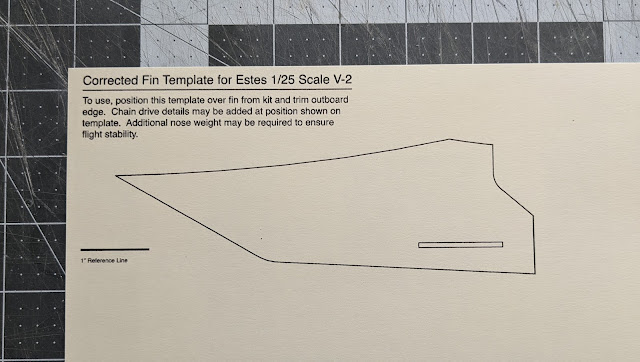The fins on the Estes V2 are large - significantly larger than scale. This is for stability.
The original V2 missile required a payload of 2,000 pounds in order to remain stable in flight. When the warhead was removed and the rocket was used to carry research payloads as an early sounding rocket, additional ballast had to be added to the rocket to make up the difference between the mass of the research payload and the warhead.
For model rockets, many "scale" kits are actually semi-scale, with a major difference between the prototype and the model being fin size. Saturn V is a good example - a flying model Saturn V will almost always have oversized fins.
The V2 fins can be cut down for a model which is closer to scale. A PDF of a fin template can be found in the files section of the National Association of Rocketry Facebook group. It's also been posted on The Rocketry Forum (CLICK HERE to go to the post).
Estes typically designs its rockets with a static margin of at least 1.5 caliber. That is, the center of gravity is forward of the center of pressure by at least 1.5 times the diameter of the body tube. For stability, a rocket should have a static margin of at least 1 caliber.
With a 1.5 caliber margin of stability, an Estes kit can tolerate some variability in building - they know some people might use epoxy for adhesive and fin fillets. But whenever you significantly modify a kit, whether it's putting in a larger motor mount for D or E motors instead of C, or adding a booster to make a two-stage rocket, or as in this case, reducing fin size for scale purposes, you MUST check stability.
The V2 will probably need a little extra nose weight. The rocket is probably slightly overstable when built stock, but as you can see from the photo at the top of this post, I'm cutting of a good bit of material here. Reducing the fin span this much will move the center of pressure forward.
I printed the PDF on card stock and cut out the template. You can see how well it fit the contour of the tail cone.
There is a small slot in the template for adding a chain drive pod, if you want to add a scale detail. It would be a small part, and at this point, I haven't decided if I'll make them. Small parts can be hard to get right, and I'd rather be happy with what I can do than ruin a model with a detail I could just as easily skip.
The template was close, but not an exact match for the kit fin. I lined up the leading edges as my reference point, and traced the new tip edge onto the fin.
That the trailing edges differed slightly didn't bother me, and trying to "fix" them might ruin them. I don't even know for sure that the PDF template is actually more correct, and nobody will notice.
I'm not going to be a stickler for scale. There are plenty of scale details I probably don't have the skills to execute without making a mess of things, so I don't plan on researching and fixing the exact contours of the aft edges of the V2 missile. But cutting fins down so they're closer to the right size - that, I can do.
I used my favorite hobby knife for cutting fin material - this oddball one from Fiskars, which I love.
Because it wraps around my index finger, I find I get a much better cut, vertically, right through the wood. I have a lot less sanding to do to square up the edges.
A side-by-side comparison shows how different the corrected fins look from the kit fins.
For a more consistent cut, I used the first corrected fin as my template to trace onto the other fins, since I could match up all the edges.
I post a lot of things on Instagram these days. Follow me here.
Like my Facebook page for blog updates and extra stuff.
Have a question you'd like to see addressed on this blog? Email me at iamtherocketn00b@gmail.com.










Please tell us more of the oddball hobby knife from Fiskars. It looks cool, but do you really have great control over the cutting blade? Where does one find one of these, and what's the cost?
ReplyDelete